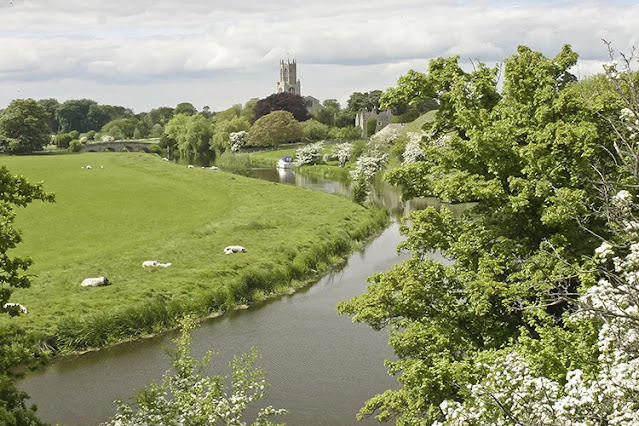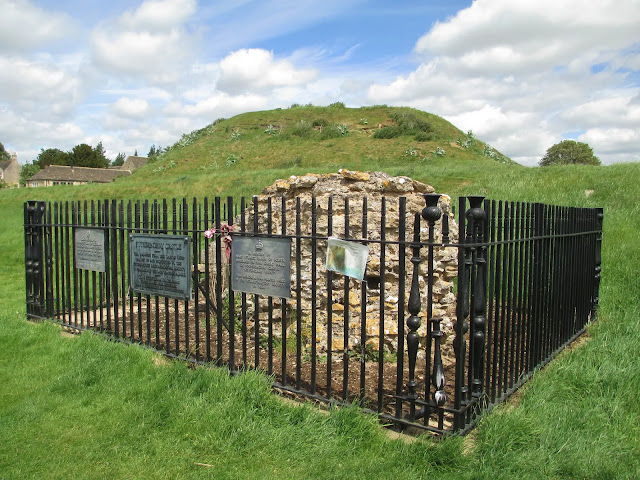 |
| It’s just to the west of Peterborough, about 85 miles north of London. |
Fotheringhay is a small village in Northamptonshire, close to Peterborough. The principal Ricardian sites are the castle, the church and the New Inn.
There is virtually nothing left of the castle since it was slighted and dismantled in the seventeenth century on the orders of King James I. The parish church has been altered over the years, and is shorter now than it was in the medieval period. However, it is still a wonderful place to visit.
The New Inn was the medieval hostel provided as an overspill for visitors to the castle. It is found at the bend in the road close to the bridge over the River Nene and though it is a private dwelling, it can be distinguished by a green plaque erected by the Society to commemorate the birth of Margaret of York, Duchess of Burgundy, in the nearby castle.
Richard III was born in the castle and legend has it that he was baptised in the church, though this event may have taken place in the castle chapel.
Little remains of the castle. There is still the mound where the keep, in the shape of a fetterlock, a Yorkist symbol, stood. Because it was here that Mary, Queen of Scots, was beheaded in February 1587, it has been suggested that her son, James VI slighted the castle when he became King of England and the building fell into disrepair. All that remains of the ancient stronghold today is a chunk of the outer stone wall, which is surrounded by a railing bearing two plaques with details about the royal connections.
Of the church, much more is left, though it is no longer as large as it would have been when Richard III was last known to have visited. In 1476, as Duke of Gloucester, he led the cortège that brought the bodies of his father, Richard, Duke of York, and elder brother, Edmund, Earl of Rutland, for reburial in the family mausoleum. At that time, the church extended further east and there was a college and cloister attached on the south, between it and the River Nene. The college was an institution for priests and choristers who daily prayed for the souls of the souls of the House of York, past and present.
 |
| Memorial to Edward of Norwich, 2nd Duke of York |
With the Dissolution, the property was sold and the roof of the choir and the cloister was stripped of its lead, allowing the rain to get in and resulting in rot and collapse. Eventually, only the nave and tower were left. As the nave was the parish church, the roof had been left alone. In 1566, when Elizabeth I saw what had happened to the tombs of her ancestors – her paternal grandmother was Elizabeth of York – she gave money for them to be reinterred in the sanctuary on either side of the altar, where they lie to this day.
The church is large, too large for the size of the present parish, and filled with light. The windows are huge and the medieval coloured glass almost completely gone. There is a modern window, the gift of the Richard III Society, which now provides a focal point for the ‘Chapel of All Souls and the memory of the royal House of York’, another gift of the Society. The window displays the heraldry of the first four Dukes of York, their wives and Richard III and his Queen, Anne Neville.
The pulpit was restored in 1966 and it now glows with colour. It was the gift of Edward IV and bears the Plantagenet royal arms, flanked by a white lion, a black bull and a white boar, symbols of the Yorkist sons. Hexagonal in shape, the pulpit stands in a narrow plinth.
The most recent addition to the furnishing of this wonderful old church is the pipe organ, built by Vincent Woodstock and installed in 2000.
Other gifts of the Society to the church include kneelers throughout the high fronted box pews and a cope for the incumbent. This is richly decorated with the heraldic history of the church. Financial support has also been given to the restoration of the bells, the building of the organ and the cleaning of the Decalogue behind the altar.














.jpg)
No comments:
Post a Comment